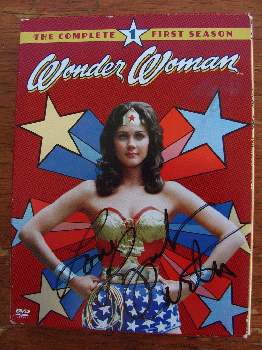
Season One of Wonder Woman signed by Lynda Carter
(Image by Castles, Capes & Clones from flickr) Details DMCA
Duluth, Minnesota (OpEdNews) June 12, 2025: In recent months, I have discussed various inter-related themes in some of my OEN articles. For example, I have explored how becoming a fan of a certain person involves being infatuated with that person and how being infatuated with a particular person is a form of love for that person.
In my case, I became a fan of the American Jesuit Father Walter J. Ong (1912-2003; Ph.D. in English, Harvard University, 1955) in the fall semester of 1964, when I took my first course with him at Saint Louis University, the Jesuit university in the city of St. Louis, Missouri (USA). Over the years, I took five courses from Father Ong. Subsequently, I devoted an enormous amount of time and energy to writing and speaking about his work. Indeed, my claim to fame is my writing and speaking about Ong's work. So, in my life, my infatuation with Father Ong as a teacher and an author of work I admired when I was a twenty-year-old junior English major at Saint Louis University in the fall semester of 1964 blossomed into a lifelong love for the man and for his work. So, infatuation is a form of love that can blossom into a deeper experience of love. In my case my love for Father Ong is the most prominent aspect of my adult life.
I have written about Ong's media-ecology thought in my OEN article titled "Walter J. Ong's Philosophical Thought" (dated September 20, 2020):
In my award-winning book Walter Ong's Contributions to cultural Studies: The Phenomenology of the Word and I-Thou Communication (Hampton Press, 2000), I survey Ong's life and eleven of his books and selected articles. My book received the Marshall McLuhan Award for Outstanding Book in the field of Media Ecology, conferred by the Media Ecology Association on June 15, 2001.
For a briefly annotated, chronologically arranged bibliography of Ong's 400 or so distinct publications (not counting translations and reprintings as distinct publications), see Thomas M. Walsh's "Walter J. Ong, S.J.: A Bibliography 1929-2006" in the anthology Language, Culture, and Identity: The Legacy of Walter J. Ong, S.J., edited by Sara van den Berg and Thomas M. Walsh (Hampton Press, 2011, pp. 185-245).
Now, around 1992, I also became a fan of the later Jungian psychotherapist and psychological theorist Robert Moore's work on the four masculine archetypes of maturity in the human psyche. According to Robert Moore, each of the four masculine archetypes of maturity involves one optimal and positive form accompanied by two bipolar "shadow" forms: (1) the King archetype of masculine maturity in the human psyche; (2) the masculine Warrior/Knight archetype of maturity in the human psyche; (3) the masculine Magician/Shaman archetype of maturity in the human psyche; and (4) the masculine Lover archetype of maturity in the human psyche. My infatuation with Father Ong and his work in the fall of 1964 involved the masculine Magician/Shaman archetype of maturity on my psyche. In audiotapes of Robert Moore's presentations about the masculine archetypes of maturity at the C. G. Jung Institute of Chicago, he frequently speaks of "mainlining" a certain "shadow" form of an archetype of maturity. His use of this drug-related expression reinforces the addictive quality of the various "shadow" forms of the archetypes of maturity.
I have written about Robert Moore's theory of the archetypes of maturity in my OEN article titled "Robert Moore on Optimal Human Psychological Development" (dated September 17, 2024; viewed 1,200 times):
Now, with Douglas Gillette as his co-author, the late Jungian psychotherapist and psychological theorist Robert Moore (1942-2016; Ph.D. in psychology and religion, University of Chicago, 1975) of the Chicago Theological Seminary published the following five books about the four masculine archetypes of maturity:
(1) King, Warrior, Magician, Lover: Rediscovering the Mature Masculine (HarperSanFrancisco/ HarperCollins, 1990);
(2) The King Within: Accessing the King [Archetype] in the Male Psyche (revised and expanded second edition, Exploration Press, 2007; original edition, 1992a);
(3) The Warrior Within: Accessing the Knight [Archetype] in the Male Psyche (William Morrow, 1992b);
(4) The Magician Within: Accessing the Shaman [Archetype] in the Male Psyche (William Morrow, 1993a);
Next Page 1 | 2 | 3 | 4 | 5 | 6 | 7
(Note: You can view every article as one long page if you sign up as an Advocate Member, or higher).




